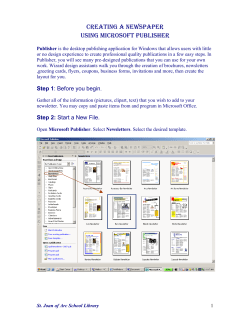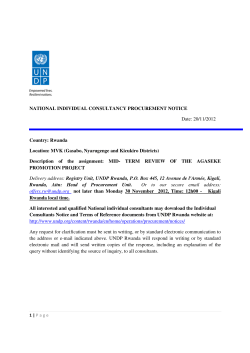
How to solve the data shift problem in Rwandan Projections
How to solve the data shift problem in Rwandan Projections Cook book, Version 0.1 (under construction) Table of Contents 1 Introduction .................................................................................................................... 3 2 Transformation methods................................................................................................. 4 2.1 Transformation from Transverse Mercator Projection with GCS ITRF_2005 to Geographic Coordinates and GCS WGS_1984 ................................................................. 4 2.2 Transformation of Transverse Mercator Projection with GCS ITRF_2005 to Transverse Mercator Projection with GCS Arc_1960 ......................................................... 8 3 Other misfits ..................................................................................................................10 4 Tips and tricks ...............................................................................................................11 4.1 5 GPS data collection in the field ...............................................................................11 Terms ............................................................................................................................12 5.1 Geographic Coordinate System (GCS ) or Datum ..................................................12 5.2 Spheroid approximates the shape of the earth .......................................................12 5.3 Projections .............................................................................................................13 5.4 Transformation: ......................................................................................................13 5.5 Geographic transformation methods ......................................................................13 6 Literature .......................................................................................................................14 7 Appendix I .....................................................................................................................14 8 7.1 Parameters for Arc_1960 .......................................................................................14 7.2 Parameters for ITRF_2005 .....................................................................................14 Appendix II ....................................................................................................................15 Chapter 7.1.2 GPS data (WGS_1984) on a map from Rwanda (Arc_1960)...................15 Esri Rwanda Ltd. Connie Schmidt, June 2012 Page 2 of 18 1 Introduction The overlay of Rwandan datasets from different sources often leads to a shift of approximately 300m N/S and of approximately 100m E/W (see Titlemap). This has been described by Dr. Werner Flacke from Esri Germany in his book1. In Chapter 7.1.2 (attached in the Annex II) he showed the method to transform Geographic Coordinates captured with a GPS using the datum WGS_1984 so that they fit with data of the Geographic Coordinate System (GCS) Arc_1960. The Geographic Coordinate System (GCS) Arc_1960 is still widely used in Rwanda although there is a strong trend within in the East African Community to move to Geographic Coordinate System (GCS) ITRF_2005 in the future. The Orthophotos (rectified Aerial Photographs) of the Rwanda Natural Resource Authority - a basis for many projects in Rwanda - are supplied in Transverse Mercator Projection with the Datum parameters in ITRF_2005. However there are cases where data will not fit together using the methods described below. Some data have no projection information at all (.prj file) or incorrect projection information or have been captured in a different scale (see Chapter “Other Misfits”). Those cases need to be treated differently: try to get more information from the data owner, try to change parameters or wrap the data (not really recommended). The following chapters in this cook book will focus on the techniques how to convert the data to have them best fit together. This is a working document. To improve the document Esri Rwanda very much appreciates your feedback. Please send your comments and questions to info@esri.rw Esri Rwanda Ltd. Connie Schmidt, June 2012 Page 3 of 18 2 Transformation methods 2.1 Transformation from Transverse Mercator Projection with GCS ITRF_2005 to Geographic Coordinates and GCS WGS_1984 When the original data has a GCS ITRF_2005 and is supposed to fit to data in WGS_1984, one needs to transform the data in two steps. However, these steps can be combined into one using the Project tool in ArcGIS Desktop. Assuming you have a project with a Shapefile of the District of Gasabo in Geographic coordinates and GCS WGS_1984 and you received new data of the District in Transverse Mercator projection and Datum ITRF_2005. When you add the new District data (ITRF_2005) to the existing one (WGS_1984) ArcMap warns you that a transformation is needed. Esri Rwanda Ltd. Connie Schmidt, June 2012 Page 4 of 18 After closing the Systems Warning the result looks like this: Using the Projection Tool you find it under the (ArcToolbox -> Data Management Tools -> Projections and transformations -> Feature -> Project) Note: To match the data, one needs to carry out a Geographic Transformation. Because there is no direct Geographic Transformation from” ITRF_2005 to WGS_1984” but there is one from “ITRF_2005_to_IRTF_2000” and then “ITRF_2000 to WGS_1984” we have to use them one after another. Please don’t get confused by the names in the transformation dialog. They work in both directions (bi-directional) and are therefore not stored twice in the GIS system. “ITRF_2005_1_To_ITRF_2000” using the Geographic Transformation “ITRF_2000_To_IRTF_2005_1” and from “ITRF_2000_To_WGS_1984” The following print screens show step by step what needs to be entered into the Projection Tool. Esri Rwanda Ltd. Connie Schmidt, June 2012 Page 5 of 18 Esri Rwanda Ltd. Connie Schmidt, June 2012 Page 6 of 18 Now all the parameters have been entered to transform the data. After the Projection and Transformation has been calculated, the District (in yellow) fits exactly to the Shape in WGS_1984. Esri Rwanda Ltd. Connie Schmidt, June 2012 Page 7 of 18 2.2 Transformation of Transverse Mercator Projection with GCS ITRF_2005 to Transverse Mercator Projection with GCS Arc_1960 Another typical case is to transform data in Transverse Mercator Projection with the GC S ITRF_2005 to Transverse Mercator with GCS Arc_1960: The Project and the Shape (RW_District_Arc_1960 are both in GCS Arc_1960. When you load data in ITRF_2005 you are asked to specify the GCS of the shapefile. Using the Projection Tool (ArcToolbox -> Data Management Tools -> Projections and transformations -> Feature -> Project) This Projection requires one more Transformation steps than the previous one. In this case we go from “ITRF_2005_1_To_ITRF_2000” using the Geographic Transformation “ITRF_2000_To_IRTF_2005_1” than from “ITRF_2000_To_WGS_1984” using the Geographic Transformation “ITRF_2000_To_WGS_1984” than from “WGS_1984_To_Arc_1960” using the Geographic Transformation “Arc_1960_To_ WGS_1984 The following print screens show step by step what needs to be entered into the Projection Tool. Esri Rwanda Ltd. Connie Schmidt, June 2012 Page 8 of 18 Perfect fit after Projection Esri Rwanda Ltd. Connie Schmidt, June 2012 Page 9 of 18 3 Other misfits Please keep in mind that there will always be a misfit if data are collected at different scales. One good example is the Road data from 1988 which where digitized from the Rwandan Topographic Maps in a scale of 1:50’000. When they are overlaid on top of an Orthophoto (with courtesy of RNRA) with a raster cell resolution of 25 cm it cannot and will never fit perfectly. One might face distances up to 40m when one zooms beyond the scale of 1:25’000. (see the lower right image below in a scale of 1:5’000) Esri Rwanda Ltd. Connie Schmidt, June 2012 Page 10 of 18 4 Tips and tricks 4.1 GPS data collection in the field You can avoid future data misfits and a lot of post processing work when you determine the Datum or the Geographic Coordinate System already in your GPS before going to the field. Depending on your reference data you have in your GIS system you should set the same reference in your GPS. Not all GPS devices have the Arc_1960 Datum stored; in this case it is safe to use WGS_1984 which can easily be converted later on to your reference system on your computer using the methods described above. If you will provide field data captured with GPS to external parties, it is recommended to capture the data in Geographic Coordinates and the GCS WGS_1984. It is very easy to convert them later on into any other Projection and Geographic Coordinate Systems. Esri Rwanda Ltd. Connie Schmidt, June 2012 Page 11 of 18 5 Terms 5.1 Geographic Coordinate System (GCS ) or Datum A geographic coordinate system (GCS) uses a three-dimensional spherical surface to define locations on the earth. A GCS includes an angular unit of measure, a prime meridian, and a datum (based on a spheroid). A point is referenced by its longitude and latitude values. Longitude and latitude are angles measured from the earth's centre to a point on the earth's surface. The angles often are measured in degrees (or in grads). The following illustrations show the world as a globe with longitude and latitude values. Defines the position of the spheroid relative to the centre of the earth. A datum provides a frame of reference for measuring locations on the surface of the earth. It defines the origin and orientation of latitude and longitude lines. The terms geographic coordinate system and datum are often used interchangeably. But a datum is only one part of a GCS and datum is an older term. The concept of a datum is included within a geographic coordinate system. 5.2 Spheroid approximates the shape of the earth Esri Rwanda Ltd. Connie Schmidt, June 2012 Page 12 of 18 5.3 Projections Are mathematical formulas to relate spherical coordinates on the globe to flat, planar coordinates. 5.4 Transformation: Moving data between coordinate systems sometimes includes transforming between the geographic coordinate systems. 5.5 Geographic transformation methods (from ArcGIS 10 Help) Moving your data between coordinate systems sometimes includes transforming between the geographic coordinate systems. Because geographic coordinate systems contain datum that are based on spheroids, a geographic transformation also changes the underlying spheroid. There are several methods, which have different levels of accuracy and ranges, for transforming between datum. The accuracy of a particular transformation can range from centimeters to meters depending on the method and the quality and number of control points available to define the transformation parameters. A geographic transformation is always defined in a particular direction. The picture above illustrates a transformation that converts from North American Datum (NAD) 1927 to World Geodetic System (WGS) 1984. When working with geographic transformations, if no mention Esri Rwanda Ltd. Connie Schmidt, June 2012 Page 13 of 18 is made of the direction, an application or tool like ArcMap will handle the directionality automatically. For example, if converting data from WGS 1984 to NAD 1927, you can pick a transformation called NAD_1927_to_WGS_1984_3 and the software will apply it correctly. 6 Literature 1 Werner Flacke/Birgit Kraus, 2005: Working with Projections and Datum Transformations in ArcGIS, Theory and Practical Examples, Points Verlag Norden – Halmsted. ISBN 39808463-5-0 ArcGIS Desktop 10 Help 7 Appendix I 7.1 Parameters for Arc_1960 Projected Coordinate System: Transverse Mercator Projection: Transverse_Mercator False_Easting: 500000.00000000 False_Northing: 10000000.00000000 Central_Meridian: 30.00000000 Scale_Factor: 0.99990000 Latitude_Of_Origin: 0.00000000 Linear Unit: Meter (1.000000) Geographic Coordinate System: Datum: D_Arc_1960 Prime Meridian: Greenwich Angular Unit: Degree GCS_Arc_1960 7.2 Parameters for ITRF_2005 Projection: False_Easting: False_Northing: Central_Meridian: Scale_Factor: Latitude_Of_Origin: Linear Unit: Transverse_Mercator 500000.000000 5000000.000000 30.000000 0.999900 0.000000 Meter (1.000000) Geographic Coordinate System: GCS_ITRF_2005 Datum: D_ITRF_2005 Prime Meridian: Greenwich Angular Unit: Degree Esri Rwanda Ltd. Connie Schmidt, June 2012 Page 14 of 18 8 Appendix II Working with Projections and Datum Transformations in ArcGIS Theory and Practical Examples Dr. Werner Flacke / Birgit Kraus Points Verlag Norden Halmstad ISBN 978-3-9808463-5-6 360 Pages, richly illustrated, paperback, June 2005 An invaluable aid for ArcGIS users: This book contains an ideal mix of background information on projections and transformations together with detailed explanations of their usage in ArcGIS. See http://www.pointsverlag.de/main.php?points=verl&page=buecher&kat=2 or amazon. Chapter 7.1.2 GPS data (WGS_1984) on a map from Rwanda (Arc_1960) Let us take a trip to Rwanda. There we encounter a CRS which is not predefined and which gives us plenty of opportunity to investigate the various aids available for defining and then implementing the correct coordinate system. Rwanda is one of the smallest countries in Africa. We have maps of a part of it at a scale of 1:50,000 and GPS coordinates registered on our arrival. Esri Rwanda Ltd. Connie Schmidt, June 2012 Page 15 of 18 It is a fair guess that you have never had to deal with a coordinate system in Rwanda before. Therefore we will not confine ourselves to discussing the steps involved in ArcMap, but also recapitulate how the necessary background information can be gathered. The legend of the raster map contains the following information relating to the coordinate system used: ‘Gauss-Krüger’ has a familiar ring to it (synonymous to ‘Transverse Mercator’). The central meridian is 30° with a scale factor of 0.9999. The false easting is 500,000, whilst the false northing is 10,000,000 (as is usual in the southern hemisphere). The modified Clarke ellipsoid from 1880 is used. This information is sufficient to identify the projection and its parameters unambiguously. Now we can look for the associated GCS. The folder Geographic Coordinate Systems \ Africa contains 71 GCS, including a number of variants for Clarke 1880 ‘modified’ (Clarke_1880_IGN, Clarke_1880_RGS, Clarke_1880_Arc). Therefore we need an even more detailed classification at country level. This is available in ArcGIS Desktop Help > Map Projections > An overview of map projections > Link: Learn more about supported geographic coordinate systems. Unfortunately, Rwanda does not appear here, Esri Rwanda Ltd. Connie Schmidt, June 2012 Page 16 of 18 so we have to investigate neighboring countries. For Tanzania we have the PCS Arc_1960_UTM_Zone_35S and the transformation Arc_1960_To_WGS_1984_3, with its reference to the Arc_1960 datum. Burundi is associated with the transformation Arc_1950_To_WGS_1984_3, Uganda to the PCS Arc_1960_UTM_Zone_35N. Thus there are two possible datums, D_Arc_1950 and D_Arc_1960. In turn, these are associated with the ellipsoids Clarke_1880_Arc and Clarke_1880_RGS, both of which fulfill the criterion ‘modified’. We choose D_Arc_1960 and Arc_1960_To_WGS_1984. This has to remain a guess, but the candidates differ only slightly. Here is a summary of the information which we have gathered using the research above as well as the file geographic_transformations.pdf (map_projection_tables.pdf in ArcGIS 8.3) and relevant PRJ files: DATUM["D_Arc_1960",SPHEROID["Clarke_1880_RGS",6378249.145,293.465]] Arc_1960_To_WGS_1984 Geocentric Translation -160 -6 -302 Kenya, Tanzania Arc_1960_To_WGS_1984_3 Geocentric Translation -175 -23 -303 Tanzania DATUM["D_Arc_1950",SPHEROID["Clarke_1880_Arc",6378249.145,293.466307656]] Arc_1950_To_WGS_1984_1 Geocentric Translation -143 -90 -294 Zaire Arc_1950_To_WGS_1984_3 Geocentric Translation -153 -5 -292 Burundi Now we have all the data which we need in order to define the CRS of the raster maps. These we load into ArcMap first, followed by the shapefile of the GPS points. Object CRS layer GCS layer Transformation Data frame and raster maps GPS shapefile Data frame CRS Data frame GCS Transverse Mercator Arc_1960 GCS_WGS_19 84 Arc_1960_To_WGS_19 84 Esri Rwanda Ltd. Connie Schmidt, June 2012 Page 17 of 18 A warning is issued which we ignore at first. Not unexpectedly, the GPS points appear with a distinct shift in respect of the roads which they were obviously supposed to represent. The shift is about 300 m. After setting the transformations a good fit is achieved. Esri Rwanda Ltd. Connie Schmidt, June 2012 Page 18 of 18
© Copyright 2025











